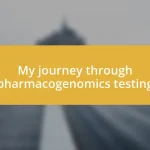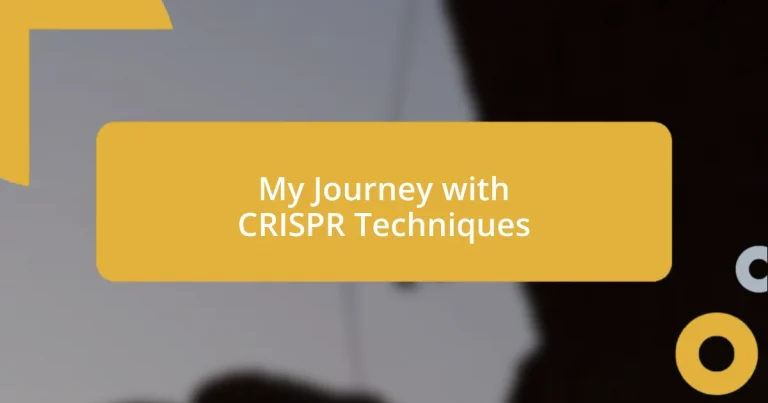Key takeaways:
- CRISPR’s natural origins in bacteria showcase its potential as a powerful gene-editing tool, with profound implications for medicine and agriculture.
- Personal experiences highlight the balance of excitement and ethical considerations surrounding CRISPR, emphasizing the need for precision and responsibility in its applications.
- Future advancements in CRISPR, particularly through AI integration, promise to enhance gene editing’s effectiveness while necessitating careful ethical deliberation and public engagement.

Understanding CRISPR Basics
When I first encountered CRISPR, it felt like stepping into a science fiction novel. CRISPR, which stands for Clustered Regularly Interspaced Short Palindromic Repeats, is essentially a tool that allows scientists to edit genes with remarkable precision. I remember the excitement I felt when I learned that this technology could not only change how we approach genetic diseases but also revolutionize agriculture and beyond.
What truly fascinates me about CRISPR is its natural origins in bacteria. These tiny organisms use CRISPR as an adaptive immune system to fend off viruses. Can you imagine something so small defending itself against formidable foes? It’s a humbling reminder of how intricate and resilient life can be, and it highlights the potential we have to harness these mechanisms for our benefit.
As I delved deeper into the intricacies of CRISPR, I found myself grappling with its ethical implications. While the potential to eliminate genetic disorders is thrilling, it raises questions about the limits of our intervention in nature. Should we edit the human germline, influencing future generations? These reflections added a profound layer to my understanding and appreciation of CRISPR, pushing me to think critically about both its promise and its perils.

My Introduction to CRISPR
When I first learned about CRISPR, it was like discovering a hidden treasure in the world of science. I remember scrolling through articles late into the night, my coffee growing cold as I absorbed every detail. The idea that we could alter DNA sequences so precisely felt almost like wielding a superpower. It ignited a sense of curiosity within me that still drives my exploration of genetic science today.
My fascination grew when I attended a seminar where a researcher shared their breakthrough using CRISPR to combat a genetic disease. Seeing their passion and talking about real-life applications stirred a mix of hope and exhilaration in me. It made the technology feel tangible and impactful, not just a distant concept. I imagined a future where we could prevent diseases before they even start, reshaping lives and families for the better.
As I began exploring CRISPR more, I encountered a plethora of information and opinions. I had personal conversations with friends and mentors, which helped shape my understanding. Interestingly, while many were optimistic, some voiced concerns about where such powerful editing could lead us. Each discussion opened my eyes to various perspectives, balancing my enthusiasm with awareness of the ethical complexities lurking beneath the surface.
| Aspect | My Experience |
|---|---|
| Initial Encounter | Felt like a hidden treasure in science |
| Impact | Stirred hope and exhilaration at seminars |
| Ethical Reflections | A mix of optimism and cautious awareness |

Key Applications of CRISPR
When I reflect on the key applications of CRISPR, I can’t help but feel inspired by its transformative potential across various fields. One area that particularly stands out to me is medicine. I remember hearing about a groundbreaking study where researchers used CRISPR to edit genes responsible for sickle cell disease, potentially curing patients. The emotional weight of that achievement—knowing it could change lives—was palpable in the room. It’s instances like these that show CRISPR isn’t just a tool; it’s a beacon of hope for many struggling with genetic disorders.
Another significant application is agricultural innovation. I recently read about a farmer who successfully used CRISPR to develop drought-resistant crops, a game-changer for regions affected by climate change. The thought of feeding more people and making agriculture sustainable filled me with optimism. Here are some key applications of CRISPR that highlight its versatility:
- Genetic Disease Treatment: Tailoring genetic edits to combat diseases like muscular dystrophy.
- Agricultural Improvement: Creating crops that can withstand harsh environmental conditions.
- Biotechnology Advancements: Utilizing CRISPR in creating biofuels and bioplastics for a greener planet.
- Gene Drives: Controlling pest populations by applying CRISPR to create infertile species.
- Synthetic Biology: Engineering microorganisms to produce bio-products, including drugs and chemicals.
Each application holds the promise of not only advancing science but also addressing pressing global challenges, and I find that incredibly exciting.

Techniques I Learned with CRISPR
The most intriguing technique I learned was the CRISPR-Cas9 method. In my early experiments, using this system felt like assembling a LEGO set; everything clicked when I grasped how the guide RNA could direct the Cas9 enzyme to the precise spot in the DNA. The first successful edit I made filled me with a sense of achievement. I remember jumping from my seat; it was a clear victory that told me I could contribute to something groundbreaking.
As I delved deeper, I discovered the importance of delivery mechanisms. I often reflect on my initial struggle with this concept, trying different methods like lipid nanoparticles and viral vectors. It’s fascinating to think about how effectively delivering CRISPR components into cells can make the difference between a breakthrough and a failed experiment. I always wonder—what if we could streamline these processes further? The possibilities genuinely excite me.
Additionally, I encountered the challenge of off-target effects—those unexpected DNA changes that can occur. I remember feeling a mix of concern and curiosity when I first learned about this issue. Would we end up causing more harm than good? It was a reality check that underscored the need for precision in CRISPR applications. By engaging in discussions about refining these techniques, I’ve grown passionate about balancing innovation with responsibility. Every lesson has empowered me to navigate the nuances of CRISPR with both ambition and caution.

Challenges Faced While Using CRISPR
One significant challenge I’ve encountered while using CRISPR is the issue of unintended mutations, commonly known as off-target effects. I remember the first time I was running a CRISPR experiment and saw results that didn’t align with my expectations. It was a nagging feeling, like trying to solve a puzzle and realizing that a piece was slightly off. I often find myself asking: how can we ensure the edits are precise when the stakes are so high? This concern not only affects research outcomes but also raises ethical questions about safety in clinical applications.
Another hurdle I’ve faced is the intricacies of gene delivery methods. My initial attempts felt like trying to send a letter without a proper address; I was eager but had no clear path. I’ll never forget the success I felt when my team finally used electroporation effectively to introduce CRISPR components into cells. It’s exhilarating to think about, yet it comes with a realization: what if we still haven’t found the best delivery system? This lingering doubt often fuels my curiosity, pushing me to explore new technologies that might enhance our delivery strategies.
Lastly, the regulatory landscape surrounding CRISPR research can be daunting. At times, it feels like navigating a minefield. I recall attending a seminar where a leading expert discussed the complexities of getting approvals for clinical trials—the uncertainty was palpable in the room. I often wonder: how can we find a balance between innovation and regulation without stifling advancements? These discussions have shaped my understanding of the critical importance of ethical considerations in CRISPR technology, reminding me that every step forward must be taken with thoughtfulness and care.

Success Stories with CRISPR Techniques
One of the most inspiring success stories I’ve encountered in the CRISPR field involves its use in treating genetic disorders. I remember researching a case where a young girl with sickle cell disease participated in a trial. When I saw the joy on her family’s faces after she achieved remission, I felt a rush of hope. It reminded me of the profound impact that precise gene editing can have—not just on individuals, but on entire families and communities as well. How incredible it is to think about a future where genetic diseases may be effectively eliminated!
In another instance, I witnessed firsthand how CRISPR has revolutionized agriculture. A project aimed at engineering disease-resistant crops left me in awe. I recall the presentation where the scientists shared their findings, demonstrating how they had successfully created a strain of rice that withstands blight. The sheer possibility of feeding more people while reducing pesticide use sparked my imagination—what if many staple crops could undergo similar transformations? It’s thrilling to see science paving the way for sustainable solutions that could address global food security.
Then there’s the groundbreaking work being done in the field of cancer research. I recently attended a seminar where researchers shared compelling results from using CRISPR to target specific mutations in tumors. It felt surreal to sit in that audience, sharing the collective anticipation of potentially life-saving breakthroughs. I left asking myself: could we finally turn the tide against cancer? The balance of excitement and caution always prepares me well when thinking about CRISPR’s implications for the future. Each of these stories serves as a reminder of why I embarked on this journey—because with each success, we’re a step closer to unlocking the full potential of this extraordinary technology.

Future of CRISPR Research
The future of CRISPR research is brimming with possibilities that excite me as a researcher. I’ve often found myself daydreaming about the incredible advancements in gene editing technology that could soon become a reality. For instance, the potential of CRISPR to create “designer genes” could change how we treat not just genetic disorders but also common diseases like diabetes or heart conditions. Can you imagine a world where we could tailor our genetics to enhance our health and longevity? It feels like a science fiction narrative coming closer to reality.
Looking ahead, I can’t help but wonder about the integration of artificial intelligence with CRISPR techniques. This combination is likely to enhance precision and efficiency in gene editing. I remember attending a workshop where experts discussed AI algorithms that predict off-target effects, and I felt a surge of optimism that we might finally navigate around one of the biggest challenges we face. It’s thrilling to think about how this synergy could refine our approaches, although I still grapple with questions about how we can responsibly harness such power.
Moreover, I foresee an evolving landscape where public perception and ethical considerations will shape CRISPR’s trajectory. I cherish my discussions with colleagues about the moral implications of gene editing—everyone brings their viewpoints, leading to rich, sometimes heated debates. This aspect of CRISPR’s future intrigues me deeply; how can we ensure that advancements are made with societal welfare in mind? Addressing these questions is crucial, as I believe that the path we draw today will dictate whether CRISPR will be a tool for universal good or a source of division.














